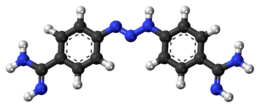Anti-parasite drug with a di-amidine
Pharmaceutical compound
Diminazene Trade names Azidin, Berenil, Ganasag, Pirocide Other names 4,4'-(1-Triazene-1,3-diyl)bis(benzenecarboximidamide) Routes of IM , SC ATCvet code Legal status
4-[2-(4-Carbamimidoylphenyl)iminohydrazinyl]benzenecarboximidamide
CAS Number PubChem CID ChemSpider UNII ChEBI ChEMBL CompTox Dashboard (EPA ) ECHA InfoCard 100.007.860 Formula C 14 H 15 N 7 Molar mass −1 3D model (JSmol )
C1=CC(=CC=C1C(=N)N)N/N=N/C2=CC=C(C=C2)C(=N)N
InChI=1S/C14H15N7/c15-13(16)9-1-5-11(6-2-9)19-21-20-12-7-3-10(4-8-12)14(17)18/h1-8H,(H3,15,16)(H3,17,18)(H,19,20)
Key:XNYZHCFCZNMTFY-UHFFFAOYSA-N
Diminazene (INN ; also known as diminazen ) is an anti-infective medication for animals that is sold under a variety of brand names. It is effective against certain protozoa such as Babesia Trypanosoma Cytauxzoon bacteria including Brucella Streptococcus [ 1] [ 2]
Chemically it is a di-amidine and it is formulated as its aceturate salt , diminazene aceturate.
The mechanism is not well understood; it probably inhibits DNA replication ,[ 1] RNA .
Side effects
Acute side effects include vomiting, diarrhea, and hypotension (low blood pressure). Diminazen can harm the liver, kidneys and brain, which is potentially life-threatening; camels are especially susceptible to these effects.[ 1]
Resistance
The Gibe River Valley in southwest Ethiopia showed universal resistance between July 1989 and February 1993.[ 3] T. congolense Boran cattle .[ 3]
References
^ a b c Peregrine AS, Mamman M (September 1993). "Pharmacology of diminazene: a review". Acta Tropica . 54 (3– 4): 185– 203. doi :10.1016/0001-706X(93)90092-P . PMID 7902657 . ^ Mungube EO, Vitouley HS, Allegye-Cudjoe E, Diall O, Boucoum Z, Diarra B, et al. (August 2012). "Detection of multiple drug-resistant Trypanosoma congolense populations in village cattle of south-east Mali" . Parasites & Vectors . 5 : 155. doi :10.1186/1756-3305-5-155 PMC 3432589 PMID 22852796 . ^ a b Mulugeta W, Wilkes J, Mulatu W, Majiwa PA, Masake R, Peregrine AS (April 1997). "Long-term occurrence of Trypanosoma congolense resistant to diminazene, isometamidium and homidium in cattle at Ghibe, Ethiopia". Acta Tropica . 64 (3– 4). Elsevier BV: 205– 217. doi :10.1016/s0001-706x(96)00645-6 . PMID 9107367 . S2CID 23878484 .

